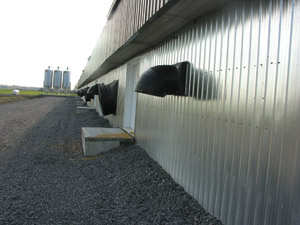
Features
Applications
Other
Researchers exploring ways to convert manure gas into fertilizer
October 9, 2008 by Candace Pollock
Many farmers are looking to manure
application for their fertility needs as a way of combating high
commercial fertilizer costs
Many farmers are looking to manure application for their fertility needs as a way of combating high commercial fertilizer costs. Now new strides in technology may soon make it possible to capture and recycle gas emissions from livestock waste as an additional source of natural fertilizer, while at the same time improving the environment.

Researchers in Ohio and Minnesota are studying the feasibility of capturing and recycling ammonia emissions from manure in poultry and swine operations using a new type of wet scrubber technology, and reapplying the fertilizer on the farm.
|
Ohio State University air quality and bio-energy researchers, along with researchers from the University of Minnesota, have received a $599,836 U.S. Department of Agriculture National Research Initiative grant to study the feasibility of capturing and recycling ammonia emissions from manure in poultry and swine operations using a new type of wet scrubber (pollution control) technology, and then reapplying the fertilizer on the farm.
“Large amounts of ammonia emissions from animal feeding operations have caused significant environmental and health concerns,” says project director Lingying Zhao, an OSU Extension specialist in agricultural air quality and bioenvironmental control. “The Environmental Protection Agency estimates in 2002 that 2.4 million tons of ammonia were emitted into the air. Meanwhile, soaring natural gas prices have raised questions about the future availability and affordability of nitrogen fertilizer for farming. This project is intended to offer animal producers an innovative tool to reduce air emission impact on the environment while generating an alternative product to commercial nitrogen fertilizer.”
The grant supports four main objectives:
to develop a wet scrubber for trapping ammonia emissions from typical animal manure storage such as deep pits, manure composting facilities or covered manure storage facilities;
to evaluate the performance, maintenance and costs of wet scrubbers on commercial farms to assess their practicality and economic feasibility;
to explore processes to convert the ammonia captured in the wet scrubber into nitrogen fertilizer; and to educate producers and livestock and poultry professionals on the technology.
Zhao, who also holds an Ohio Agricultural Research and Development Center appointment, says the wet scrubber technology is not new, but the type being used for the purposes of the research is.
Most effective wet scrubbers used to remove gaseous pollutants are known as packed towers, in which air pollutant vapors are absorbed by liquids over the surface of packing material.
“Packed towers, however, cause significant pressure drop and energy consumption and don’t operate well with agricultural ventilation fans, which normally move large amounts of air at lower pressures,” says Zhao. “They are used in Europe for smaller farm operations, but when you are talking about large animal facilities with many fans, the cost to install the packed-type wet scrubber does not make the technology feasible.”
Zhao and her colleagues have been focusing on a spray-type of wet scrubber that operates by capturing gas in water/acid liquid droplets normally sprayed in the device. The ammonia gas is transferred to the liquid via air being passed through, and then recycled. Such wet scrubbers are generally used to collect dust particles and not gaseous pollutants, and are of lower efficiency than packed towers.
Researchers are working to improve on the technology and optimize the design to increase the scrubber’s efficiency. They developed a prototype of the scrubber in the lab, collecting 70 to 90 percent of ammonia emissions depending on the operating conditions, and are now interested in testing the prototype in the field.
“From our results in the lab, we see the potential the scrubber has on an animal farming operation,” says Zhao. “Scrubber technology is complex. What we want to do is create a small-scale scrubber applicable to a farm. If a composting facility generates approximately 100 tons of ammonia annually, and the scrubber is efficient, even at only 70 percent collection efficiency, 70 tons of ammonia can be collected and recycled for use on the farm.”
The three-year grant is part of USDA’s Cooperative State Research, Education, and Extension Service air quality competitive grants program. The USDA has awarded $5 million to 11 universities to conduct air quality projects aimed at developing and evaluating emission control technologies.